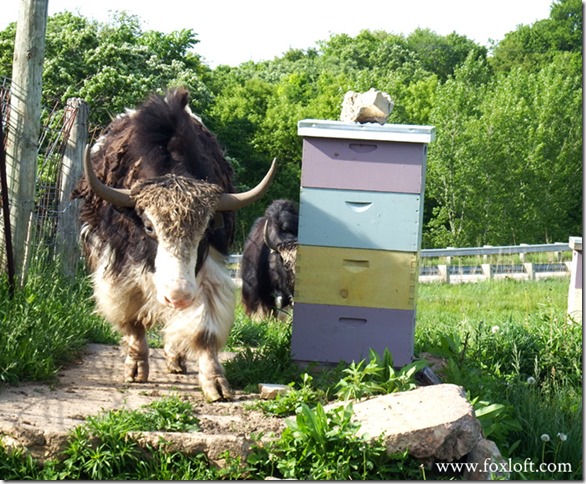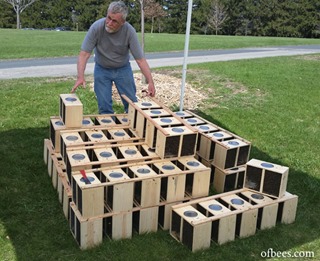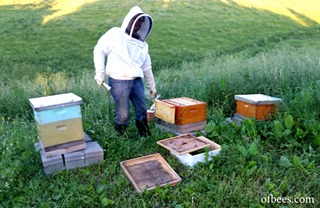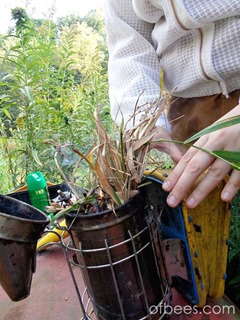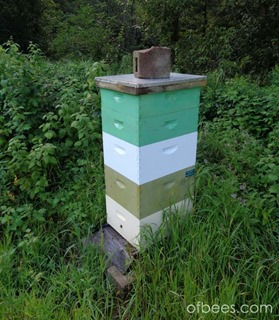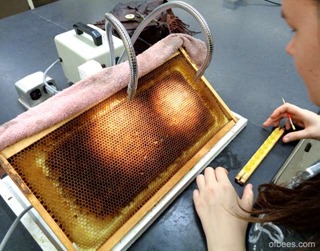One of our methods of installing new package bees into a hive, using sugar syrup to distract them and directly releasing the queen.
Preparing for Bees
We had decided to get bees, we had taken a class about beekeeping, we had read our books, we had the backing of many generous sponsors – so now what? The first step was to get the supplies we needed to house and care for the bees. We placed our order with a large local […]
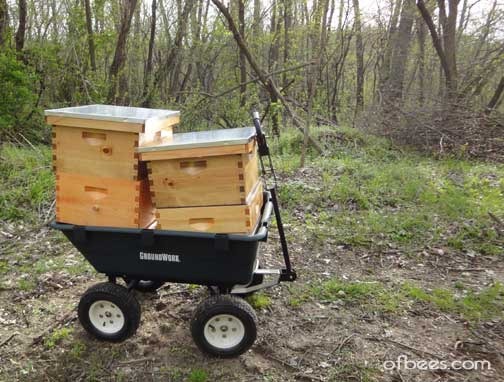

Our Bee Adventure Begins
Where did this all start? I didn't grow up dreaming of an apiary. I didn't give it a whole lot of thought until one day I wondered just how doable it would be for an average person to keep bees - did you need specialized training/knowledge? How much time would it take? Would it even […]
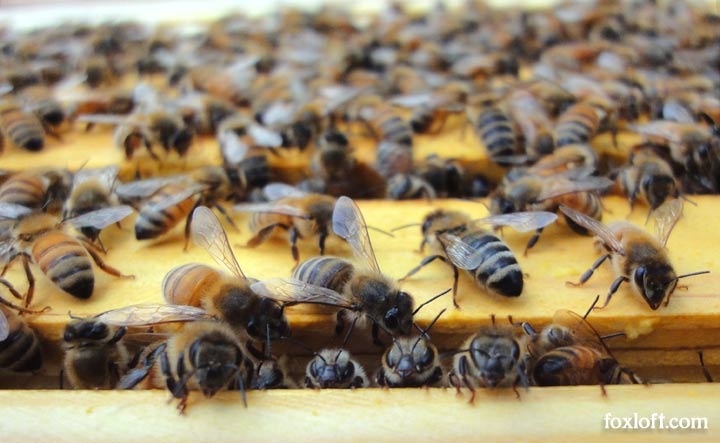

Beginning Beekeeping
Thanks to all of our generous and awesome donors from our Kickstarter campaign, we now have bees! We have successfully set up our first apiary and have been photo documenting the process of getting, installing, and checking on our new bees. :) It's been absolutely amazing so far - despite the fact our bee suits […]
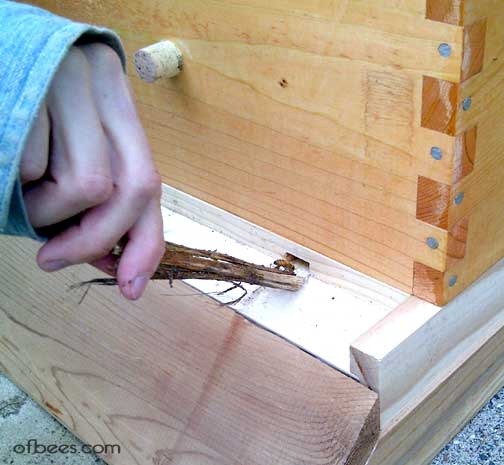

Yak-Proofing the Bees (Summer 2016)
 September 24th, 2016
September 24th, 2016  Foxfeather Ženková
Foxfeather Ženková I suppose it’s probably not a typical problem, but we needed to ‘yak-proof’ our bees this year. Our apiary is in a large pasture with our small herd of Tibetan yak (and one Highland cow), who conveniently discovered that the hives made great scratching posts. To prevent incidents, we decided to build a yak-proof fence around the hives so everyone could live in harmony.
2016 Spring Hive Installations
 May 1st, 2016
May 1st, 2016  Foxfeather Ženková
Foxfeather Ženková Some local beekeepers have been kind enough to organize transport of package bees for everyone in our area. These package bees come from California from large breeding apiaries. Northern climates like ours (Minnesota) are not able to produce new packages with ready-to-go queens this early in the year so they have to come from warmer places where bees are active year round. Most purchased packages come from California, Georgia, or Texas. They are moved by semi-truck one time a year, so beekepers band together to place bulk orders for bees.
2015 Apiary Year Review
 February 4th, 2016
February 4th, 2016  Foxfeather Ženková
Foxfeather Ženková Spring hive installations
2015 was an incredibly busy year for our fledgling farm! We moved to our new location in April and established our new apiary, built a chicken coop (promptly filling it with chickens), then added heritage turkeys, ducks, geese, pigs, yak, and a highland cow to our small homestead.
Mead-Making
 January 29th, 2015
January 29th, 2015  Foxfeather Ženková
Foxfeather Ženková If honey is properly ‘cured’ (dehydrated by the bees through wing-fanning to a specific moisture content), it will last indefinitely when stored properly. If the honey is ‘wet’ (more than about 19% moisture content), though, it will ferment. This year, we had quite a bit of wet honey so we decided to try our hands at making mead (honey wine)!
We used the book The Compleat Meadmaker as our basic guide, along with a bunch of specific recipes from various sources online. We decided to try out three meads – a cyser (apple cider mead), a ginger mead, and a plum melomel.
State of the Apiary, Honey Harvest, and Candlemaking – 2014
 October 24th, 2014
October 24th, 2014  Foxfeather Ženková
Foxfeather Ženková 2014 was a productive year for us, with all seven colonies of bees flourishing and establishing well, building up and preparing well for our long Minnesota winter. We also had our first chance to render extra beeswax (a byproduct of honey harvesting) and make some candles! Here is a photo of our smoker. We use grasses, twigs, and leaves from around the farm to produce the smoke which helps calm the bees as we work with them. The smoke works because the bees act as if there is a wildfire – eating as much honey as they can (in preparation to leave the hive with resources if a fire is coming) instead of being defensive. Since it is just used in a small amount for a short time, it doesn’t hurt them, just distracts them so we can work.
2014 Hive Share Sponsors
 September 28th, 2014
September 28th, 2014  Foxfeather Ženková
Foxfeather Ženková A huge thank you to all of our 2014 Hive Share sponsors, who were a major help in the expansion and running our our apiary this year!
This particular hive was sponsored by Ursula Vernon. The queen was Carniolan and the bees built up slowly but caught up really well by the end of the season!
You can learn more about our hive share program here: https://ofbees.com/hive-shares/
Queen Rearing Classes–June 2014
 June 28th, 2014
June 28th, 2014  Foxfeather Ženková
Foxfeather Ženková Foxfeather preparing to graft bee larvae – part of the process of raising queen bees.
Having been pretty enraptured by the bees and really enjoying our apiary, the next logical step for us was to explore the idea of breeding our bees and raising our own queens. Right now we (and most folks in the Midwest) get bees from large commercial operations in California or Georgia, but it would be nice to work on developing local stock and being less dependent on bees shipped in from across the country. On a commercial scale this would be pretty much impossible, since the optimal time for raising queen bees (summer) and starting new colonies (spring) does not match up – it is going to take some special management to make it work, but it is possible! We are really lucky to have the University of Minnesota relatively local to us and to get accepted into their yearly queen-rearing classes.
New Bee Installation–Spring 2014
 April 22nd, 2014
April 22nd, 2014  Foxfeather Ženková
Foxfeather Ženková
Thanks in large part to our awesome hive share sponsors, we installed seven new colonies of bees in our apiary this spring!
First Honey Harvest!
 October 1st, 2013
October 1st, 2013  Foxfeather Ženková
Foxfeather Ženková In the fall of 2013, we had our first honey harvest! Here in Minnesota the bees need about 100lbs of excess honey for themselves to get a colony through the winter, and since we don’t feed them sugar syrup or take their own stores away, we don’t get a whole lot of excess. Our bees had a pretty productive year, however, and we were able to bring some home and experience the process of collecting and bottling the honey by hand.

